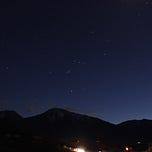I sat out on the balcony of my cousins condominium, situated just north of Seattle. It was about 5am, and a palate punching cup of French roast Keurig coffee warmed my hands. Stars blanketed the deep dark sky and a pale glow began to move up the horizon. As with all our kind, staring up at the stars filled me with reverberations of meaning and wonder. I let my mind wander between empty spaces, fathoming astronomical distances. The absurdity of the vast volume of space between me and the nearest star buoyed my imagination, carrying me up, out, and beyond into the impossibly far reaches of the universe. I sit on a planet, orbiting a star, which in turn orbits a supermassive black hole, which is drifting with a galactic cluster through a backdrop of space littered with galaxies too numerous to number or comprehend. Such a reality demands an awed silence.
I could see the constellation Orion shimmering brightly in the dawning light. His belt of three especially luminous stars stood out, their proximity suggesting the figure of a trim and fit warrior. I realized, too, that the actual relationship between the stars in the Orion constellation holds no real pattern. The appearance of a warrior with a belt, a sword, and a bow is just that: an appearance. From our perspective, it looks like the stars cut the figure of a man shooting a bow, but in three dimensional space the stars have little to no relation to each other. They are flying hundreds if not thousands of light years apart from each other. There is no Orion, actually, is there?
This is similar to the concept of pareidolia, wherein people see the reminder of a human face in everyday objects. The faces aren’t really there, though. Instead, happenstance that certain marks or colors arrange themselves relative to each other in similar relative proportions to our own faces makes us “see” their relative positions as the pattern of a face. But, there is no face, actually, is there? It’s just a coincidence.
There isn’t actually any meaning in the stars. It’s just a coincidence, a glitch of our own pattern-seeking brains; brains which demand to find significance behind the coincidental state of the universe. There are no signs. There is no ultimate purpose. There is no meaning to the planets, stars, space, time, atoms, animals, ocean waves, or the movie Interstellar. You have no purpose, no meaning, no actual enduring substance. It is merely coincidence that the random bits of matter that make up your body came together to form the illusory momentary mirage of meaning that defines your entire existence.
Of course, I don’t believe any of that. That’s not to say I believe that Orion actually exists in some sort of external human-independent reality, either. It used to be, perhaps, that ancient cultures had a direct metaphorical understanding of the constellations. That constellation is Orion, who is locked in an infinite pursuit of the Pleiades sisters. The ancients didn’t have physically accurate understanding of what the stars were, or the fact that there alignment in a certain pattern was a coincidental state, that the pattern was in their own minds. With the dawning of scientific thought, humanity began to put into practice objectivity, wherein the observer removes themselves from the equation to see what and how things actually exist. By changing the way we see the world around us, we enabled ourselves to harness the resources of the natural world in a whole new way, giving rise to the astounding breadth of technology we have today. It’s hard to argue with the results. Clearly the pursuit of rational, objective, literal, material, and linear thinking is a superior state of being.
There is a dilemma, however, in walking down the road of infinite objectivity, and its parallel street, reductionism. There is no reasonable end point or destination. All things must be pulled apart and seen from a non-participatory perspective. Inherent to the concept of objectivity is the removal of one’s own status as a participant in the reality being observed. A little imagination will show us that to tread too far down this road will, as I wrote above, lead to the loss of meaning and purpose. Mechanistic explanations lend themselves to objectivity and reductionism, up to and surpassing our own conscious experiences. The meaning of our lives and our experience are reduced, explained away, so that our subjective realities can be abolished in the pursuit of an increasingly objective reality. We’ve already done away with God, now it’s time to do away with ourselves.
There might be several ways to counteract this slide into atomistic oblivion. One path might be to point out, as I have done, that there is no end in sight. Another way might be to demonstrate the logical clog of being a subjective observer; all observations made by anyone are, by definition, subjective. There is another interesting path by which we might resist the loss of meaning and purpose, and that is to take another look at the faces in stone.
The possibility someone might see coincidental patterns in a rock as a face presents an interpretive decision tree with no logically necessary choice. It is reasonable and true to explain away the pattern as mere coincidence. There is no intentional meaning in the rock, because there is no intentional meaning to the state of the universe. The patterns we see that remind us of our own faces aren’t really there, in the universe, they are here, in us. And this is the second option on the decision tree. The patterns we see in the universe are here, in us. But, we are part of the universe. If we see faces in the rocks, it’s because we are imbuing the universe with a holographic representation of our own meaning. Or, is it the other way around? Is the universe holographically presenting it’s meaning through us? Yes to both. If we came from the universe, and we see meaning in the universe, then the universe has meaning, and that meaning is us.
The fact that we see faces in coincidental states of the universe is an astounding revelation of our meaning generating subjective conscious experience. This revelation harkens back to Orion, to the myths of old, to God himself. Para: alongside, near, around, close to. Edoilon: image. We, being made in the image of God, are the pareidolic pattern of God, God seeing a pattern in us that is close to his own image.
Myth gives way to science, because myth is blind to the independent reality of the physical world. But science, in turn, must give way to something else. It is blind to the wholistic intuitive meaning of myth. Perhaps we are at the beginning of something new? Is there a category beyond myth and science, one which makes room for the strengths of both, while protecting against their blind spots? Whatever that might be, it will not be a synthesis of two equal and opposite realities. For there is one more axis along which myth and science have very divergent qualities.
The scientific road increasingly dismisses myth and metaphor, dissecting, reducing, and dissolving meaning and purpose. Yet the converse is not true. Myth does nothing to diminish scientific endeavor and understanding. Rather, it can comfortably accommodate the pursuit of objective understanding. Myth allows for science to flourish in it’s discovery, attenuation, and refining of materialistic conceptions of the universe. In fact, the reach and scope of myth can be vastly expanded by taking into consideration the findings of whatever current scientific investigations turn up.
One road leads to a broadening and deepening of understanding, purpose, and meaning. One road leads to a destruction of all three. Furthermore, because the road of science leads to the destruction of purpose, meaning and understanding, those who follow it blindly lose even the understanding that they’re losing their understanding. It is a road which gets narrower and narrower, stripping away the relevance of purpose, blind to its own purpose.
So, what’s next? Let me know in the comments below what you think!














Share this post